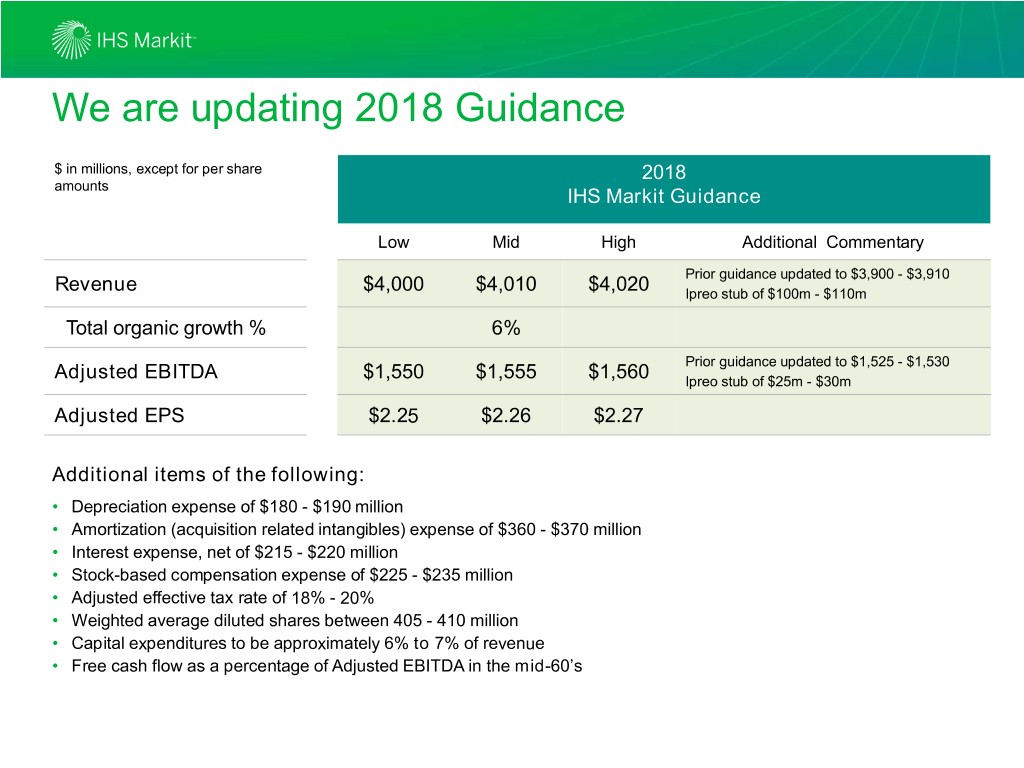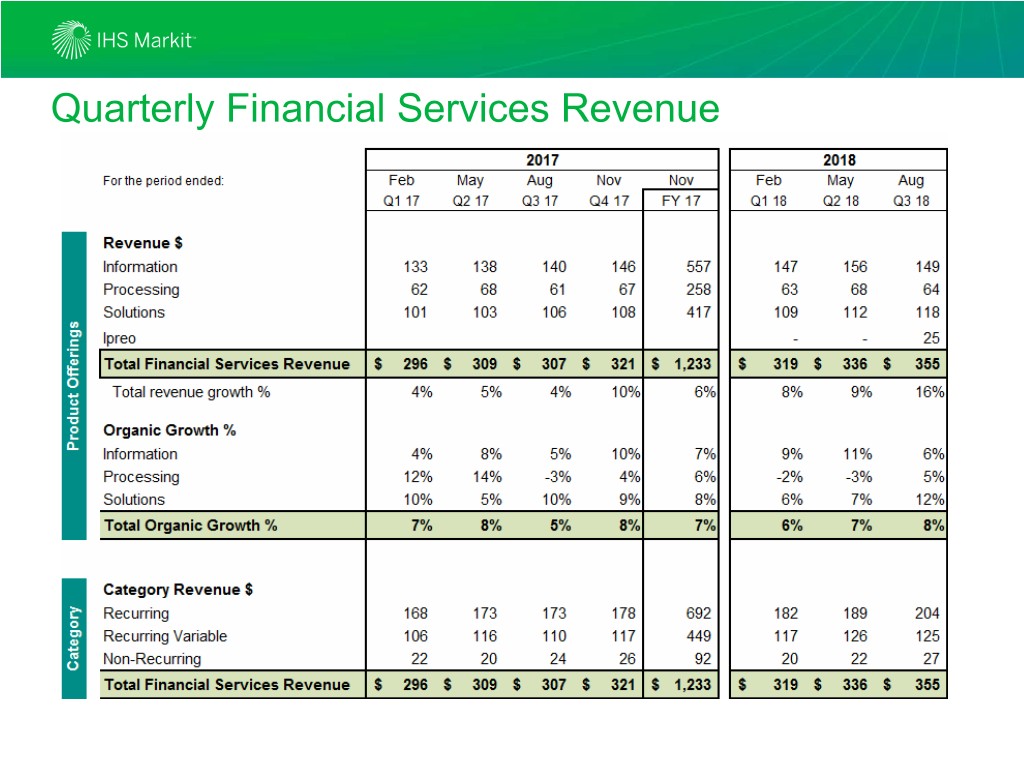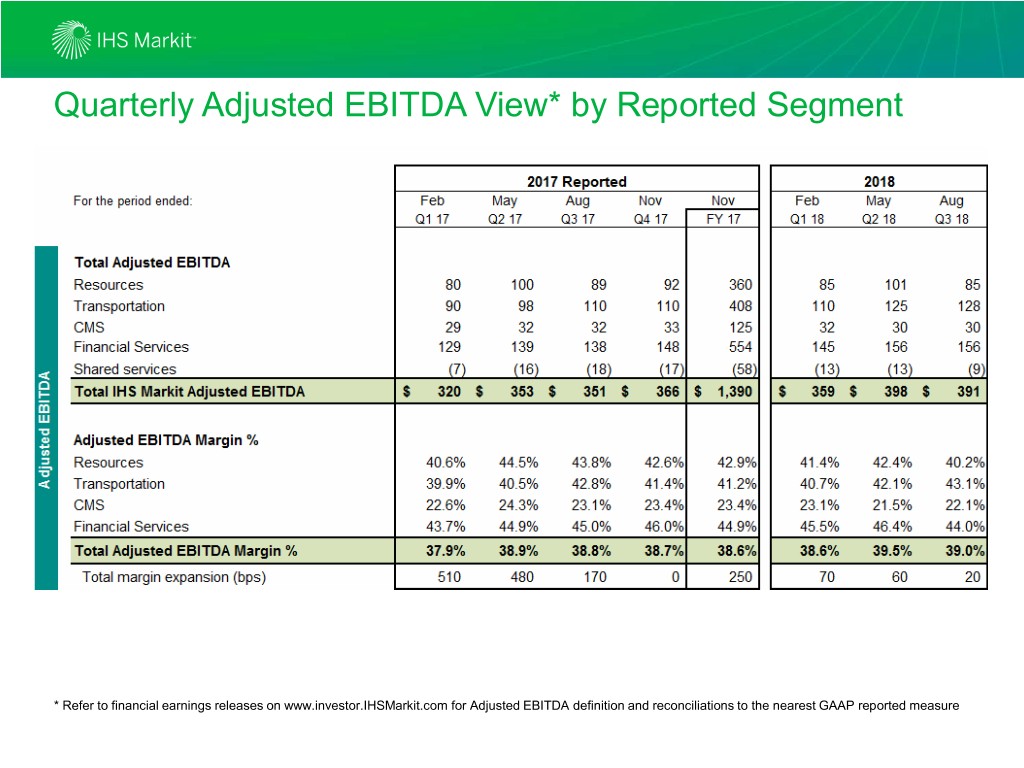Attached files
| file | filename |
|---|---|
| EX-99.1 - MEDIA RELEASE - IHS Markit Ltd. | exh991q318.htm |
| 8-K - 8-K - IHS Markit Ltd. | q3-18earningsrelease.htm |

Q3 2018 Earnings Supplemental Financials September 25, 2018

Forward-looking statements This presentation contains “forward-looking statements” within the meaning of the federal securities laws, including Section 27A of the Securities Act of 1933, as amended, and Section 21E of the Securities Exchange Act of 1934, as amended (“Exchange Act”). In this context, forward-looking statements often address expected future business and financial performance and financial condition, and often contain words such as “anticipate,” “intend,” “plan,” “goal,” “seek,” “aim,” “strive,” “believe,” “see,” “project,” “predict,” “estimate,” “expect,” “continue,” “strategy,” “future,” “likely,” “may,” “might,” “should,” “will,” “would,” “could,” “target,” similar expressions, and variations or negatives of these words and the use of future tense. Examples of forward-looking statements include, among others, statements we make regarding: guidance and predictions relating to expected financial and operating results, such as revenue growth and earnings; strategic plans, actions, and objectives, including acquisitions and dispositions, anticipated benefits from strategic plans, actions, and objectives, including acquisitions and dispositions and the merger between IHS Inc. and Markit Ltd., and our success in integrating acquired businesses; anticipated levels of capital expenditures in future periods; our belief that we have sufficient liquidity to fund our ongoing business operations; expectations of the effect on our financial condition of claims, litigation, environmental costs, contingent liabilities and governmental and regulatory investigations and proceedings; and our strategy for customer retention, growth, product development, market position, financial results, and reserves. Forward-looking statements are neither historical facts nor assurances of future performance. Instead, they are based only on our current beliefs, expectations, estimates, and assumptions regarding the future of our business, future plans and strategies, projections, anticipated events and trends, the economy, and other future conditions. Because forward-looking statements relate to the future, they are subject to inherent uncertainties, risks, and changes in circumstances that are difficult to predict and many of which are outside of our control. Important factors that could cause our actual results and financial condition to differ materially from those indicated in the forward-looking statements include, among others, the risks discussed under the caption “Risk Factors” in our Annual Report on Form 10-K, along with our other filings with the U.S. Securities and Exchange Commission (“SEC”). However, those factors should not be considered to be a complete statement of all potential risks and uncertainties. Other factors may present significant additional obstacles to the realization of forward-looking statements. Consequences of material differences in results as compared with those anticipated in the forward-looking statements could include, among other things, business disruption, operational problems, financial loss, legal liability to third parties and similar risks, any of which could have a material adverse effect on our consolidated financial condition, results of operations, credit rating or liquidity. You are cautioned not to place undue reliance on these forward-looking statements, which speak only as of the date of this presentation. Any forward-looking statement made by us in this presentation is based only on information currently available to us and speaks only as of the date of this presentation. We do not assume any obligation to publicly provide revisions or updates to any forward-looking statements, whether as a result of new information, future developments or otherwise, should circumstances change, except as otherwise required by securities and other applicable laws. Non-GAAP measures Non-GAAP financial information is presented only as a supplement to IHS Markit’s financial information based on GAAP. Non-GAAP financial information is provided to enhance the reader’s understanding of the financial performance of IHS Markit, but none of these non-GAAP financial measures are recognized terms under GAAP and should not be considered in isolation from, or as a substitute for, financial measures calculated in accordance with GAAP. Definitions of IHS Markit non-GAAP measures to the most directly comparable GAAP measures are provided with the schedules to the most recent IHS Markit quarterly earnings release and are available on IHS Markit’s website (www.investor.ihsmarkit.com). This presentation also includes certain forward looking non-GAAP financial measures. IHS Markit is unable to present a reconciliation of this forward looking non-GAAP financial information because management cannot reliably predict all of the necessary components of such measures. Accordingly, investors are cautioned not to place undue reliance on this information. IHS Markit uses non-GAAP measures in its operational and financial decision making, and believes that it is useful to exclude certain items in order to focus on what it regards to be a more reliable indicator of the underlying operating performance of the business and its ability to generate cash flow from operations. As a result, internal management reports used during monthly operating reviews feature non-GAAP measures. IHS Markit also believes that investors may find non-GAAP financial measures for IHS Markit useful for the same reasons, although investors are cautioned that non-GAAP financial measures are not a substitute for GAAP disclosures. Non-GAAP measures are frequently used by securities analysts, investors and other interested parties in their evaluation of companies comparable to IHS Markit, many of which present non- GAAP measures when reporting their results. These measures can be useful in evaluating IHS Markit’s performance against its peer companies because it believes he measures provide users with valuable insight into key components of GAAP financial disclosures. However, non-GAAP measures have limitations as an analytical tool. Non-GAAP measures are not necessarily comparable to similarly titled measures used by other companies. They are not presentations made in accordance with GAAP, are not measures of financial condition or liquidity and should not be considered as an alternative to profit or loss for the period determined in accordance with GAAP or operating cash flows determined in accordance with GAAP. As a result, you should not consider such performance measures in isolation from, or as a substitute analysis for, results of operations as determined in accordance with GAAP.

We are updating 2018 Guidance $ in millions, except for per share 2018 amounts IHS Markit Guidance Low Mid High Additional Commentary Prior guidance updated to $3,900 - $3,910 Revenue $4,000 $4,010 $4,020 Ipreo stub of $100m - $110m Total organic growth % 6% Prior guidance updated to $1,525 - $1,530 Adjusted EBITDA $1,550 $1,555 $1,560 Ipreo stub of $25m - $30m Adjusted EPS $2.25 $2.26 $2.27 Additional items of the following: • Depreciation expense of $180 - $190 million • Amortization (acquisition related intangibles) expense of $360 - $370 million • Interest expense, net of $215 - $220 million • Stock-based compensation expense of $225 - $235 million • Adjusted effective tax rate of 18% - 20% • Weighted average diluted shares between 405 - 410 million • Capital expenditures to be approximately 6% to 7% of revenue • Free cash flow as a percentage of Adjusted EBITDA in the mid-60’s

Quarterly Revenue by Reported Segment

Quarterly Organic Growth

Quarterly Financial Services Revenue

Quarterly Adjusted EBITDA View* by Reported Segment * Refer to financial earnings releases on www.investor.IHSMarkit.com for Adjusted EBITDA definition and reconciliations to the nearest GAAP reported measure
